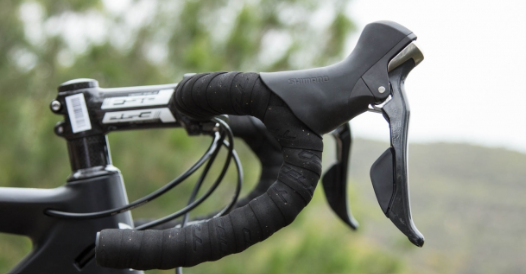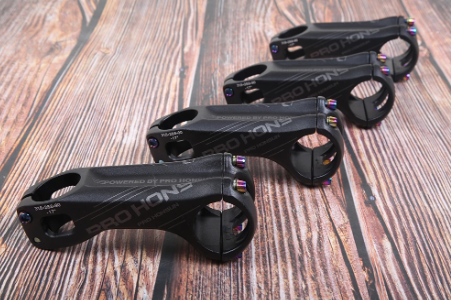What Is The Best Stem Length For Your Road Bike?
Basically, the most common stem length is 100-110 mm. But we don’t have the only right answer to this question. You need to constantly try to find the most suitable setting for the stem length. Different rider’s physical characteristics and riding habits lead to different optimal choices.

Why Choosing The Right Stem Is Important?
The selection of proper stem length can improve the riding comfort, controllability and efficiency. Therefore, it is worthy of attention and careful consideration. A suitable stem can reduce too much pressure on the wrist and while provide good support. Different types of bicycles may require different types of stems to meet their specific handling needs. The right stem length provides stable handling and flexible steering. Each cyclist has his/her own unique physical characteristics and preferences, so it is necessary to select the appropriate stem according to the needs and preferences of the individual. For example, some may prefer a longer stem to provide more support, while others may prefer a shorter stem to provide more controllability.
Longer stem : pros and cons
Pros of longer stem
The longer stem provides a wider support area, making riding more stable. This is particularly advantageous for novice riders or those who ride in uneven terrain. It allows the rider to take a more relaxed and comfortable position, reducing arm and shoulder fatigue. Although it may slightly increase the turning radius of the bicycle, it may also provide better manoeuvrability for some cyclists. Especially at high speed or where precise handling is required, the longer stem provides greater leverage and makes it easier for cyclists to control the cycle. Some of the longer grip designs are designed to improve aerodynamic efficiency and reduce aerodynamic drag so that the rider moves faster. This is particularly advantageous for cyclists seeking speed and performance.

Cons of longer stem
But the longer stem also showed some defects. The longer stem may make the steering performance of the bicycle slightly limited and not as flexible as the shorter stem. This may create a degree of inconvenience when frequent turns are required or when riding on narrow paths. For shorter riders, the longer stem may be too large to fit into their body proportions, resulting in impaired ride comfort and handling. Longer stem usually use more material and may increase the weight of the bike. This may have an impact on the acceleration and gradeability of the ride.
Summary on longer stem length
Longer stem offer a more stable, comfortable and manoeuvring experience, particularly suited for long journeys or high-performance cyclists. However, for specific needs, such as frequent turns or small stature cyclists, longer stem may not be the best choice.
Shorter stem : pros and cons
Pros of shorter stem
The shorter stem allows the rider to steer and control the bicycle more easily. This is particularly advantageous for cyclists who need to turn frequently or ride on narrow paths. Frequent parking, starting and turning are often required in urban environments. The shorter stem makes these operations easier and therefore more suitable for urban cycling. Shorter handholds usually lead to a more upright position, which helps reduce back and neck fatigue and improve ride comfort. For smaller riders, shorter stem may be more appropriate because they are better suited to their body proportions.

Cons of shorter stem
The shorter stem also shows some weakness. Shorter stems may reduce bicycle stability, particularly at high speeds or in cross-wind conditions. This may make it unsafe to ride. Shorter bars provide smaller hand support areas and may not provide comfort, particularly when cycling for long periods of time, which may result in hand fatigue or discomfort. A shorter grip may increase the air resistance during the ride and thus reduce the speed. This can be an adverse factor for cyclists seeking speed and performance.
Summary on shorter stem length
Shorter stems are ideal for more flexible handling, urban cycling and smaller riders, but may sacrifice some stability and comfort.
Stem Length Affects Gravity Center & Stability
SUMLON believes that the most important aspect of changing the position of the center of gravity and handling flexibility is the change of the stem. If you are good with the center of gravity and handling flexibility setting of the stem in use, we do not recommend that you consider purchasing and using a different length of stem.
Different lengths of stem can directly affect the position of the driver’s center of gravity. Changing the center of gravity is very important in the ride. Suppose you do want to increase the load on the front wheels, you can move the center of gravity forward by using a longer stem.
If the length of the stem has reached the limit that the body can withstand, then reducing the height of the stem by 5 mm may also brings a huge change in the overall geometry. If you feel the center of gravity is not stable during the ride, try changing the stem to solve the problem. In addition, a longer grip necessarily results in a larger forearm swing radius, and vice versa. Theoretically, the larger the radius, the more labor-saving, suitable for drivers with smaller upper limb strength and the desire to make subtle movements. In some difficult road sections, the longer stem can improve the controllability, but at the same time, the upper limb moves longer.
In most cases, we don’t have many options. What we can do is to take the specifications of stems into consideration when selecting the frame, and constantly try.
BTW, SUMLON have been manufacturing bicycle parts for over 15 years. Contact us if you are looking for a bike parts factory or a one-stop wholesaler. Peace.




